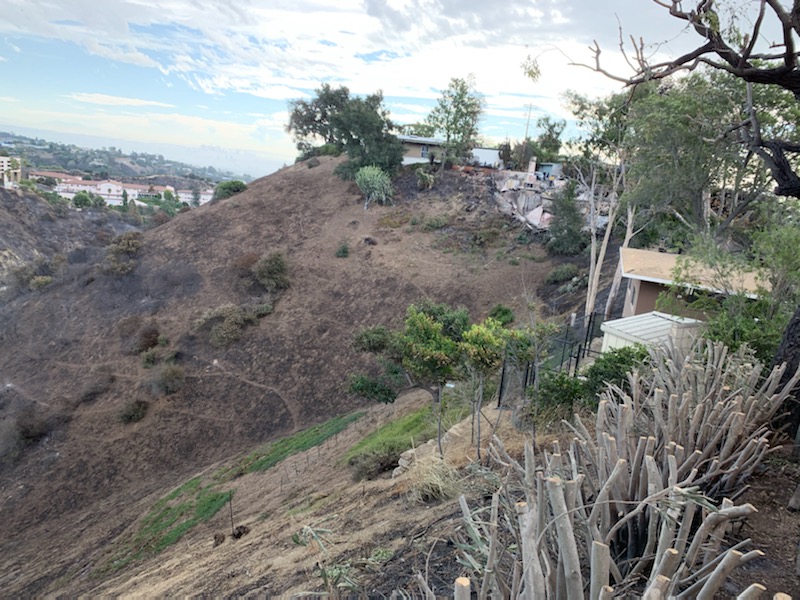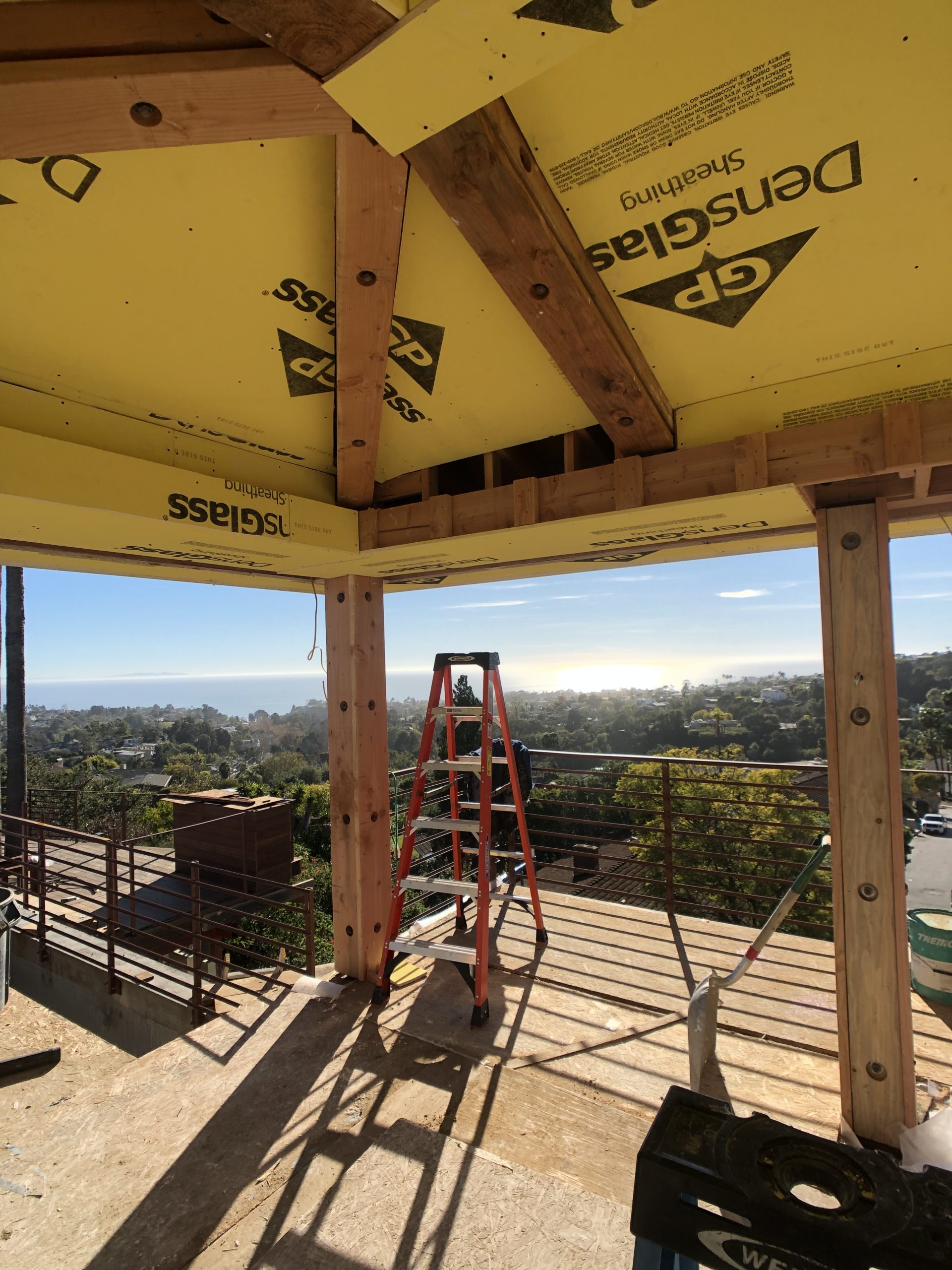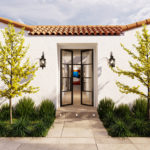The threat of wildfires can be scary. Your mind turns to concerns for your family, friends, neighbors, pets, and wildlife. The thought of losing your home and material possessions along with all the memories are irreplaceable items that can be overwhelming.
After the devastating Getty Fire and the recent Sepulveda Fire, homeowners may be wondering if there is a way to fire-proof their home. While it is easier to carefully plan the design of a new home to be fire-resistant, there are steps anyone can take to better protect their home and mitigate the damages of wildfires. The following steps may not spare your home, if it is on the path of a wildfire, but there have been instances where preventative measures have made a difference.
Where to Start: Protecting your Home from the Outside
Wildfires attack your home first from the exterior, driven by strong winds that fuel the first to reach high temperatures in seconds. The wildfire may pass by your site and the danger may seem gone within minutes, but the danger of secondary spot fires that start by wind-driven flames and embers is ever present. If your home is designed to withstand this brief, but devastating exterior onslaught, your home has a good chance of surviving a wildfire.

The California Building Code requires materials and construction methods to protect our home from wildfires, but some additional measures to consider are:
Site Design
Create a ‘defensible space’ of 100 feet distance between your home, combustible materials, and the wildlands. Wildfires can come in any direction, but up-hill fires are by far the most dangerous. This area deserves special attention. Site your home away from ridgetops, canyons, and areas between high points of a ridge.
Landscaping
Create what Cal Fire calls a “Lean, Clean, Green Zone,” by removing all flammable vegetation within 30 feet immediately surrounding your home. Then create a “Reduced Fuel Zone” in the remaining 70 feet, which can be achieved with horizontal or vertical spacing between plants or removing all plants below the trees.
- Large trees do not need to be removed but trim lower tree branches at least 6 feet from the ground
- Landscape with fire-resistant plants. On hillsides, ice plants are a great choice. Engineer Stan Quan of the Los Angeles Fire Department provided the photo shown here of homes and hillside burned during the Getty Fire, with the exception of the ice plants shown, which helped save this home from being destroyed.
- Maintain plants with regular water and remove dead branches, leaves, and needles.
- Take special care when clearing vegetation with lawnmowers or brush clearers, as one spark can start a fire. String trimmers are a much safer alternative.
- Woodpiles should be stacked at least 30 feet from all structures. Remove vegetation within 10 feet of woodpiles.
Visibility & Access
When designing your site, consider driveways and turnarounds that are wide enough for a fire truck, equipment, and emergency vehicles to access your site. In addition, a turn-around space will help if they need to leave in a hurry. Make it easy for your firefighters to get close to and around your home.
- Post your house address so that it is easily visible from the street, especially at night. Address numbers should be at least 3 inches tall and on a contrasting background.
- Clear flammable vegetation at least 10 feet from the road and 5 feet from your driveway
Emergency Water Supply
Maintain an emergency water supply that meets fire department standards through either a community water supply or fire hydrant, a cooperative emergency storage tank with neighbors, or a minimum storage supply of 2,500 gallons on your property, such as a pond or pool.
Roofs
Install a fire-resistant roof. In addition, remove dead leaves and needles from your roof and gutters.
- Common problems are openings and cracks in Spanish tile roofs that allow embers to enter the attic or roof sheathing. Fire-stop individual tiles in an existing roof, and for new roofs choose tiles or fire-rated materials with a tight interlock and installed over a fire-resistant cap sheet.
- For flat roofs, gravel or ballast can be installed to protect the roof membrane from burning embers.
- To help defend and imminent fire on a flat roof, plug the downspouts and drain lines and fill your roof with a layer of water, creating a pond to defend against flying embers.
- Remove all dead branches overhanging your roof and keep branches 10 feet from your chimney.
- Cover your chimney outlet and stovepipe with a nonflammable screen of 1/2 inch or smaller mesh

Exterior Walls
There are plenty of beautiful and regionally appropriate materials for the exterior of your home, including stucco, brick, concrete, tile, adobe, cement board, concrete block or metal siding. Any of these materials can be designed in any architectural style you wish. Materials like wood can still be used, but a layer of fire-resistant material, such as exterior grade drywall must be installed below to increase the wall’s fire rating.
Overhangs
Roof soffits, cantilevered balconies, decks, and underfloor areas should be given particular attention because this is where flames will be trapped and temperatures reach their highest. Consider double layers of fire-resistant materials or a firewall.
Windows
Windows are often the weakest point of defense against a fire. A wildfire’s radiant heat alone can shatter glass. Single glazing is particularly vulnerable.
- Consider double-glazed windows with tempered glass on the exterior side.
- Roll-down metal fire doors or fold-down panels or shutters are perhaps the safest solution and can be designed seamlessly into the overall design. They can recess into the roof overhang or side recesses and released automatically by fusible links.
- For fixed windows, there are many kinds of wire glass or fire safety glass
Doors
Because solid core wood doors are typically fire rated for 20 minutes, consider a metal core door that can be faced in any material and using a metal jamb.
- Garage doors are particularly vulnerable. Metal panel doors with an automatic fusible link closure and tight seals are critical because winds can easily slide a burning ember under the door.
Vents & Louvers
Consider fire dampers with fusible links on attic and under-floor vents. A minimum of 1/4″ metal wire mesh or tighter can also be used.
- Check that all bathroom, dryer, and kitchen vents have automatic back-draft dampers and fire-rated assemblies that penetrate the exterior skin of the building.
- Metal sleeves and hoods should cover plastic plumbing vents that penetrate the roof.
Sprinkler Heads
Sprinkler heads can be placed on the roof or decks and can turn themselves on automatically with a valve that is opened with a fusible link.
Photovoltaic Panels
Solar panels will not only help protect your roof but can produce stand-alone power to your home in case of an emergency. In addition, a portable generator should be considered to automatically power exterior lights and to pump water out of your pool.
Protecting your Home from the Inside
Although wildfires attack from the outside, there are things you can do from the inside to protect your home.
Garage
Mount a working fire extinguisher and have tools such as a shovel, hoe, rake and bucket available in case of a wildfire emergency. Consider installing a solid door with self-closing hinges between living areas and the garage.
Fire Sprinklers
While fire sprinklers are required in all new homes in California, this should be considered during any remodeling.
Kitchen
Keep a working fire extinguisher in the kitchen. Maintain electric and gas stoves in good operating condition, and make sure all electrical outlets are designed to maintain appliance loads.
Living Room
Install a screen in front of a wood-burning fireplace or wood stove
- Store the ashes from your fireplace and barbeque in a metal container and dispose of only when cold.
- Clean fireplace chimneys and flues at least once a year.
- Windows are often the first area that a wildfire penetrates, setting the draperies off like a Roman candle. You can choose fire-resistant draperies or roller shades.
Hallway
Install smoke detectors between living and sleeping areas
- Test smoke detectors monthly and replace batteries twice a year, when the clocks are changed in the spring and fall.
- Replace electrical cords that do not work properly, are frayed or have loose connections.
Bedrooms
Install a smoke detector in the bedroom, especially if you sleep with the door closed.
- Turn off electric blankets and electrical appliances when not in use.
- If you have security bars on your windows and doors, be sure they have an approved quick-release mechanism so you and your family can escape in the event of a fire.
Bathroom
Disconnect appliances such as curling iron, hairdryers and store in a safe location until cooled. Also, keep items like towels away from wall and floor heaters.
In addition to this, a Disaster Preparedness Kit is also essential for every home, in case of an emergency.
Unfortunately, with climate change, wildfires are becoming much more frequent. As we begin to rebuild after the recent wildfires, these basic design decisions will greatly improve the chances that your home will survive the next wildfire.





